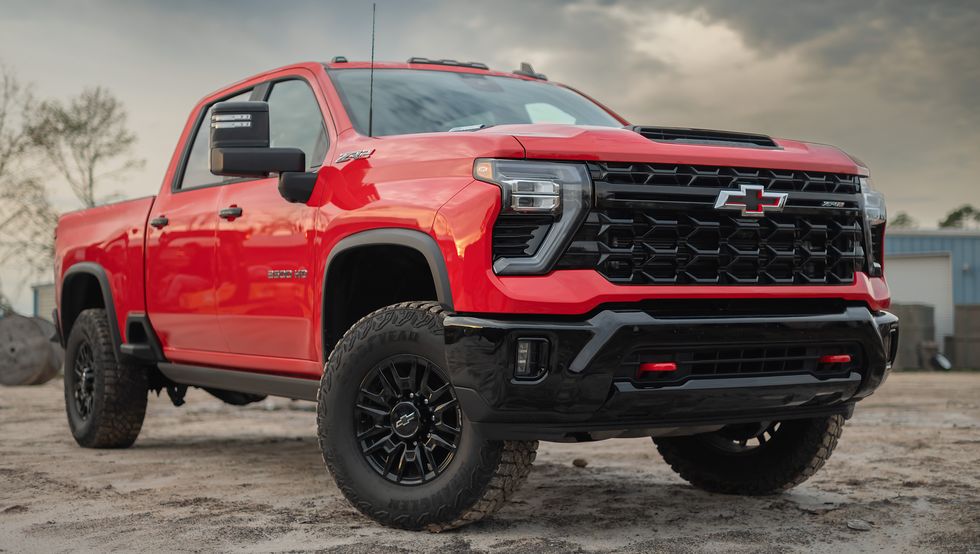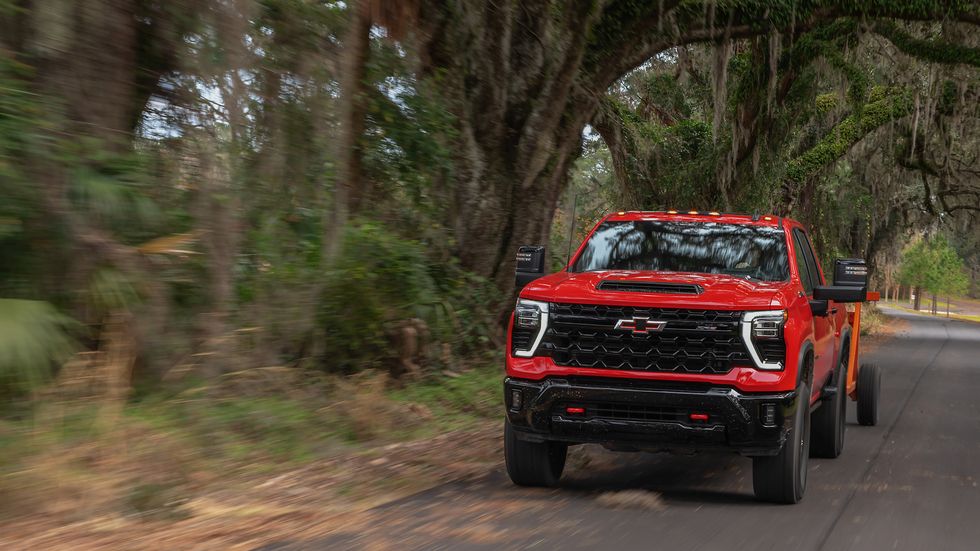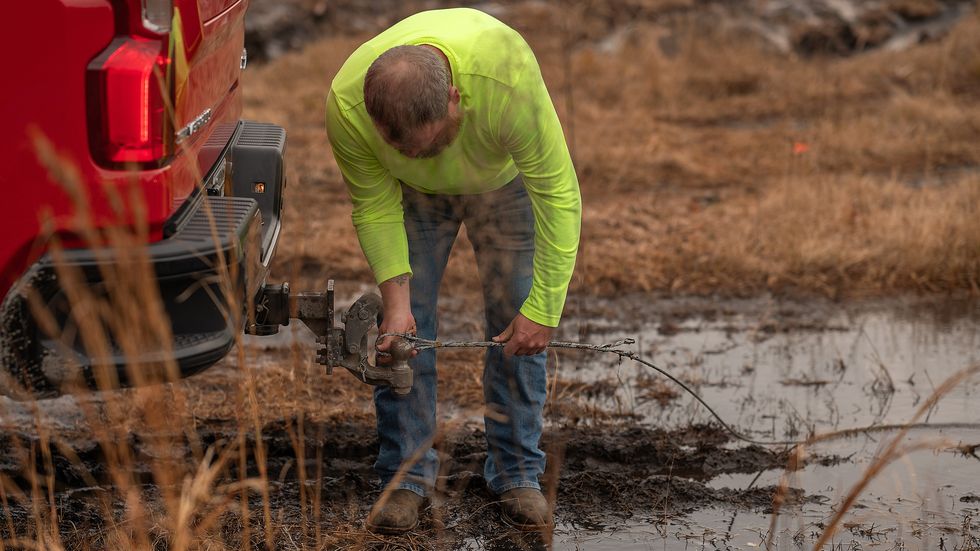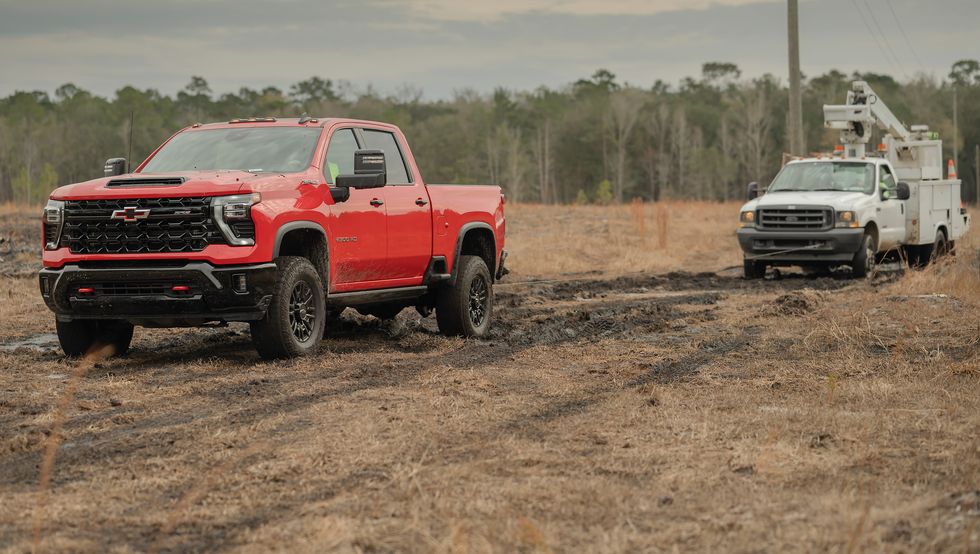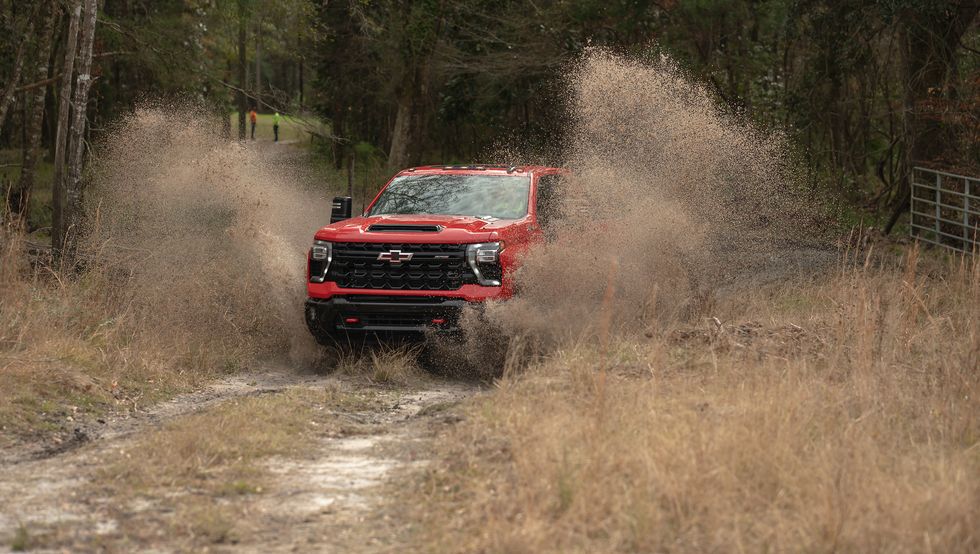“What are you gonna use that for?” It’s a question that applies to many of our favorite machines: supercharged V-8 muscle cars, 1000-hp electric sedans, 200-mph two-seat European road missiles. It also hangs over the new breed of off-road-oriented heavy-duty pickups, like the Chevrolet Silverado HD ZR2. These goliaths seem too huge for trail work and too stiff for desert running, yet nonetheless feature all-terrain tires, a lifted suspension, and locking axles. What are you gonna use that for? Power and telecommunications line work, that’s what. And even better if said line work is in Florida, the lifted HD pickup’s natural habitat.
Outside of cities, our nation’s electrical and data lines are predominantly strung up on poles, and these poles are not always conveniently situated along paved thoroughfares. For jobs involving maintenance or running new lines, you need a truck that is both an off-road monster and a beast of burden. If the towering International 4×4 bucket truck is the big boss of line work, then a pickup like the HD ZR2 is the loyal henchman standing alongside cracking knuckles, ready to do the dirty work. The big Silverado gets a 1.5-inch suspension lift, 35-inch Goodyear Wrangler Territory MT tires, an electronic locking rear differential, and the magical Multimatic DSSV dampers, here in size XXXL. The underbody is armored with an aluminum front skid plate and a steel shield for the transfer case. With the 470-hp 6.6-liter diesel under its hood, the ZR2 can tow 18,500 pounds and carry more than 3000 pounds of payload. Just the thing, then, to tow a spool of cable far out yonder or drag a stuck bucket truck out of the mud.
To test the ZR2’s line-work acumen, I head to northern Florida, where my friend Keith Wilson runs his linework company, Yukon Utility. Wilson lives in Perry, about an hour south of Tallahassee, in a region known as the Forgotten Coast. Around this area you’ll find the Iron Horse Mud Ranch, Tate’s Hell State Forest, and the Sopchoppy Worm Gruntin’ Festival, an event that I think needs no further explanation. This part of Florida also has no shortage of line work, for reasons both unlucky and endemic. On the former front, last fall Perry made national news when Hurricane Idalia barreled into town with 125-mph sustained winds, peeling off roofs and knocking out power for 93 percent of the county’s residents. That certainly created plenty of repair work, but the ZR2 and I will be jumping into an entirely different project, closer to the state capital—running fiber-optic lines into rural areas, part of the Bipartisan Infrastructure Law’s bid to expand Internet access across the country. “These people have never had internet?” I ask. Wilson replies, “Man, some of these people have never had phones.”
It’s dangerous work, as evidenced by Wilson’s two broken arms. A few weeks before, he was unlatching a strap that secured a boom truck’s bucket arm when the boom—under hydraulic tension, as it turned out—suddenly released and catapulted him skyward. He landed arms-first in the back of the truck, breaking his arms, wrists, and several ribs. Understandably, and maybe for my benefit, the morning meeting at his shop is heavy on safety briefings.
When you’re up in the air in a bucket or on a pole, working around live wires with power tools, you don’t want to slip into careless reverie. Wilson hands me a climbing helmet, which is not so much to protect your noggin on high as it is on the ground. “When someone drops a wrench out of the bucket, you’ll be glad to be wearing that,” he says. Leaning against a wall is an ominous tool called an anchor cranker that’s used to set pole anchors in the ground and can drag an unwary user right along too. Over in the training area, where new recruits learn the basics of line work, somebody’s drawn eyeballs around two stiff wires sticking out of the wall. Kids, wear your eye protection. Also watch out for clueless drivers, sagging high-voltage lines, and the whereabouts of the boom—whether you’re in it or not. And then there are the locals, some of whom have easements on their property for line work but aren’t necessarily happy about it. Gravity, electricity, humanity: These are your everyday line-work hazards.
At Wilson’s shop, his crew formulates the day’s plan before daybreak and then heads down the road to the spool yard to pick up supplies and further assignments. The red ZR2 is an object of curiosity as a spool of fiber optic cable is forklifted onto a trailer behind it. The yard’s project manager, James, is intrigued by the multi-flex tailgate, and I demonstrate how it can flip down into different positions. I’m careful to avoid its bed-step configuration, also known as the “dent your tailgate with your own hitch” position. (Indeed, this almost-new truck already has a spherical dent where someone else made that mistake.) With the tailgate down, onlookers note approvingly that the ZR2 is set up to haul a gooseneck trailer—evidence of a serious truck, that.
However, it’s the only GM truck I spy in the yard. Around these parts, independent front suspension is still viewed with suspicion, evidence that your truck has tangible commonality with a Toyota Corolla and you yourself might be a Communist. To which I say, “Really? I mean, independent suspension is sturdy enough for Army MRAPs but not pickup trucks?” Wilson, who knows his trucks—he used to own the off-road shop that built my diesel Bronco—has an answer. “When you’re sitting sideways in a ditch all day, IFS will wear out ball joints way early,” he says. His personal truck is a diesel Ford F-350 with a utility body and 37-inch Toyo mud-terrains. “I just put those on last week,” he says. “In case I need to tow you out.”
We’ll see about that. Getting stuck is part of the game, especially when Florida gets soaked with storms, as it has recently. But line workers have a unique advantage when it comes to getting unstuck, in that most off-roaders aren’t traveling with enormous spools of steel cable rated for 14,000 pounds. When a bucket truck gets hopelessly mired, the crew can craft their tow line as long as they please, so the recovery machine might be parked in the next county. The week prior, one of Wilson’s crew dragged out a truck from the first spot he could find traction, which was 1000 feet away. This is one of the reasons why Yukon runs mostly rear-wheel-drive trucks—the 4×4 bucket trucks can carry a $50,000 premium, so may as well stick with rear-drive and tow as needed. Plus, if you get a 4×4 bucket truck stuck, it’s really stuck. Wilson does have one monster 4×4 bucket truck, but it’s an 8.2-liter Detroit Diesel–powered, Rockwell-axled weapon of last resort that tops out at 62 mph and thus doesn’t usually see action too far from headquarters.
But our first project is tame work for the ZR2: towing the fiber-optic spool along the shoulder ahead of a bucket truck to lash the communications line to the steel cable spanning the poles. This is accomplished using a 40-pound metallic cylinder that looks like a miniature rocket ship as envisioned by Jules Verne. One worker up in the bucket buttons everything up around the poles—the braider can travel between poles but must be reset for each span—while someone else on the ground pulls the lasher with one hand and drags cable off the spool with the other. A third person drives the truck and keeps it as close to the pole line as possible, which usually means navigating the ditch or shoulder while keeping the trailer and its $5000 worth of fiber-optic cable upright.
I try all three roles and find I’m happiest on the ground, dragging cable by hand. Up in the bucket, lashed in with climbing gear and peering up at 7200 volts coursing along not far enough overhead, is unnerving and involves much line-work jargon—maybe someday I’ll know what to do when I’m asked for a handful of bug nuts and some good-girls. And as for driving the spool truck, it’s low-grade stressful to maintain a consistent slow walking pace while keeping an eye on the rearview mirror, navigating culverts and trying not to block driveways. And this is an easy run. But a more difficult test is right around the corner, a section of poles stretching across a field. Given the recent weather, it’s debatable whether we can tackle that work today. But since we have the ZR2 handy, we decide to give it a try.
Yukon’s Lamar Weatherly ventures into the field with one of the Ford bucket trucks, backing in to see how it’ll go. Weatherly makes it perhaps 100 yards down the line before the truck digs into a standoff with the panhandle gumbo. I’m disappointed, because this run of poles leads to a pond that would require use of the rope gun—a Batman-worthy device that fires a rope across water so that line can be run to the opposite side—but now we’ll get to test the red Chevy’s recovery-vehicle mettle against 14,000 pounds of immobilized bucket truck.
Weatherly clips off perhaps 50 feet of steel cable and runs it from the Ford’s bumper to the ZR2’s pintle hitch. The Chevy’s locking rear differential has no speed limitation, so I lock it and cockily leave the truck in rear-drive mode to see if I can roost my way out of this without engaging four-wheel-drive. This, it transpires, is a mistake, and I need to unhook and use low-range four-wheel-drive just to extract the ZR2 from a literal and figurative pit of hubris. Wilson and his towering F-350 are parked not far away, and he’s cheerfully rooting for me to get stuck so that he can use his Ford to save both the ZR2 and the bucket truck. But with the ZR2 repositioned and hunkered down in four-low, its 975 pound-feet of torque are brought to bear, mud flies, and I feel a wave of relief as the Chevy hits the end of its steel tether but begins inching forward, dragging its recalcitrant partner like a dog who’s refusing to leave the park.
Those poles will wait for another day, but the ZR2’s proven it has the chops to handle line work’s unique decathlon, a contest of brute strength and off-road acumen. And thanks to the Silverado’s day on the job, there are some households that will soon have high-speed internet access for the first time. Those people, though, probably won’t use it to search “Silverado HD ZR2 what do you need that for?” They already know the answer.
Ezra Dyer is a Car and Driver senior editor and columnist. He’s now based in North Carolina but still remembers how to turn right. He owns a 2009 GEM e4 and once drove 206 mph. Those facts are mutually exclusive.

